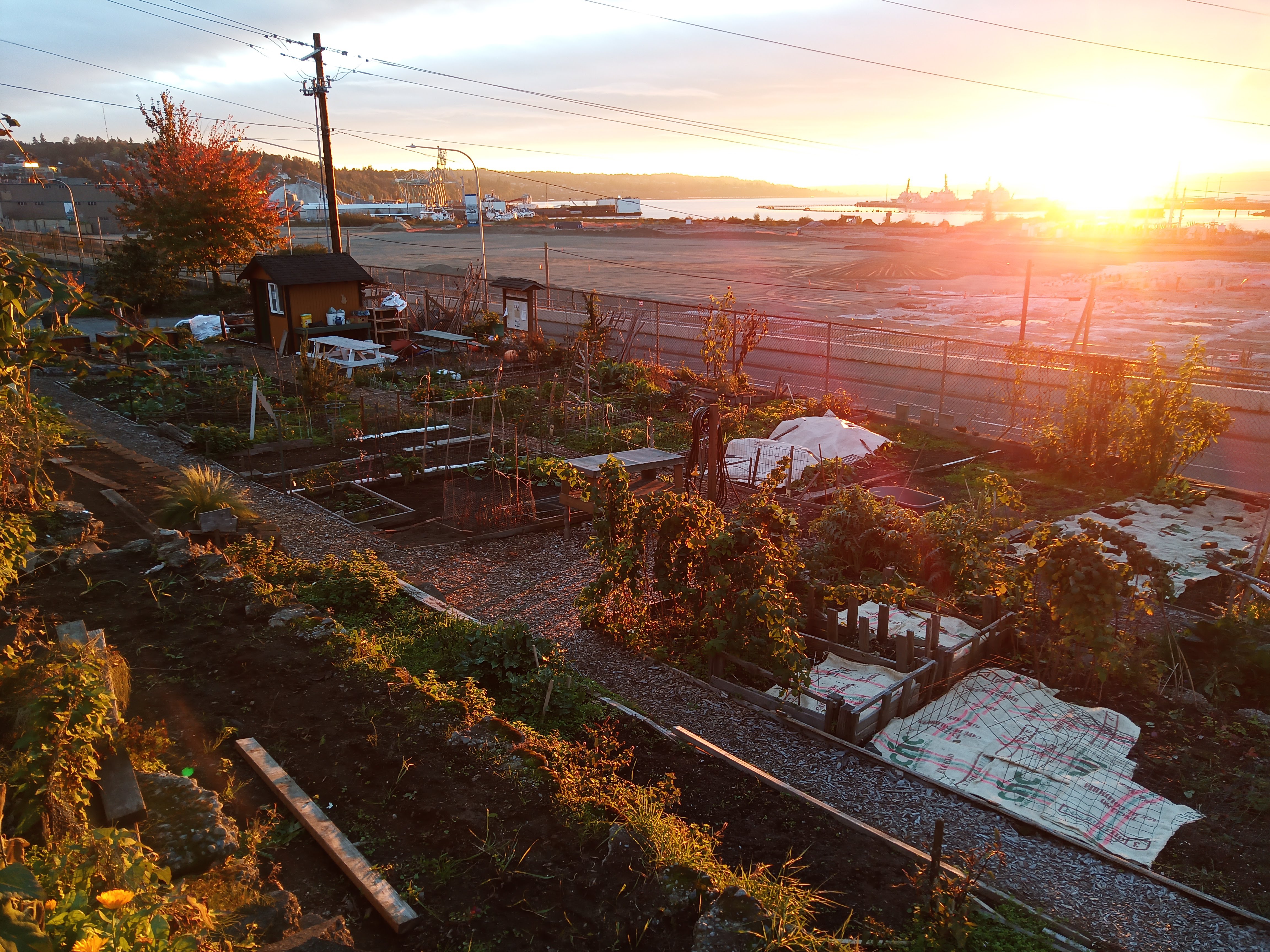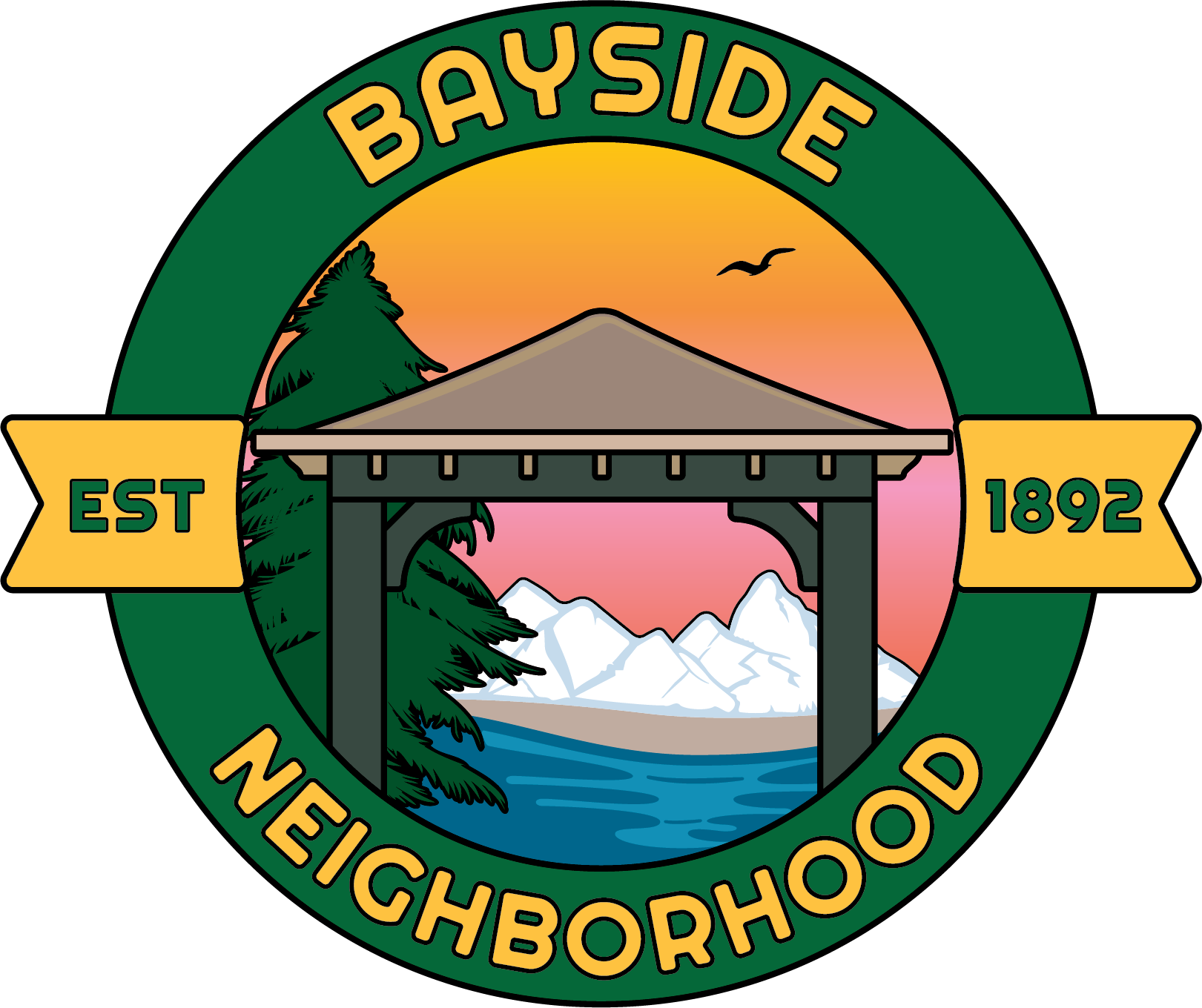Early History of the Bayside Neighborhood Centennial P-Patch cont'd
The Bayside Association steps in and Scott Paper steps up When I started attending Bayside Meetings, Bill Belshaw was Chair. With his background in City Planning, he easily found the name of the property owner. The property was owned by Scott Paper. They had purchased it for potential expansion of their parking lot located just south of the vacant land, but it turned out their existing lot was sufficient to meet their employee needs, so they never developed it. Hence, it sat vacant with no immediate plan for use. Bill and I spoke to them about the problems created by the vacant lot. Scott Paper was responsive and promised to take action to alleviate the problems. They seemed receptive to the idea of leasing the property to the Neighborhood Association as they did not need it but were happy to have the community make good use of it. Knowing this, discussion began at Bayside Meetings as to what could be done with the property. Even if we convinced Scott Paper to clean up the land, the problem would continue - the weeds would grow back, and the place would continue to attract nuisance behavior like the dumping. A long-term solution was needed. Bill talked to the City of Everett Parks Department about taking the property to develop as a park. They gave a lot of help and suggestions as to what could be done and even, at one point created a drawing of a potential park. However, they could barely make a dent in the project for less than $15,000 and there was no money in their current budget but said maybe in a few years they could take it on. I was not willing to wait since the problem was immediate for the neighborhood and people had been dealing with the nuisance for years. The work had to start immediately.

I am not sure who suggested the community garden option, but it seemed the ideal solution to the problem. We did not have enough money to hire people to create and maintain a park, so it made sense to make a community p-patch garden instead where participants would have a vested interest in not only creating the garden but maintaining it into the future. We had a $3,000 block grant that could be used for the project but would be stretched very thin considering the magnitude of the effort. Lots of volunteer labor was needed given the huge amount of work to be done. If the City Parks Department wanted to step in later and help, our initial efforts would not conflict with that. Some in the Neighborhood Association had reservations about our plans, but the time was right to take some immediate action and this seemed the most sensible approach. So, at this point, we entered into an agreement on behalf of the Bayside Neighborhood Association with Scott Paper to lease the property for $1.00 per year indefinitely. We told them of our plans for a p-patch and they were very supportive and enthusiastic. We promised to let people know they had helped create the garden and our sign in the garden reflects that commitment. Now the Hard Work Begins
Scott Paper jump-started our effort when they sent in bulldozers to scoop all the debris and vegetation into a big pile near 23rd. My father, Dave Edlen, was living at my home at the time. He and other neighbors observed the process from the alley and cheered as the land was cleaned up. Dave and I were out of town. I was sorry to miss the spectacle. My Dad said it was quite a spectacle, watching the heavy equipment scoop up trees and garbage. I think it took several days. Then it was our turn. The Bayside Neighborhood had its first official piece of property to develop so we had to get moving. I started recruiting volunteer help while Bill hired someone to bring in another bulldozer. He knew an operator who would work at a very reasonable rate and half our $3,000 budget was allocated to his work. We got more than our money's worth as he put in a lot of extra time since I think he came to personally support the project. The rest of our grant money had to be stretched to cover garbage disposal and putting in water service. Supplies like hoses and seed for erosion control were also necessary. We also needed a sign. It seemed like mission impossible at some points, but we just kept pushing forward. The property is a triangle shaped piece of land 100 x 200 ft and was sloped from the alley down to the bulkhead and fence separating it from Marine View Drive. It was decided that terracing the property in two long pieces made the most sense. We would create garden plots on the upper terrace and the lower terrace and initially plant wildflowers on the slopes to prevent erosion. But first, the place had to be cleaned up. The pile of garbage and debris had to go. We arranged with Rubatino Refuse for a commercial size dumpster to be dropped at the end of the street on 23rd. Once they realized what we were trying to accomplish, they were very generous with their services. They waived most the dumpster rental fee and took away two full loads and I do not think they ever billed us. It was great as I am not sure we could not have stayed on budget otherwise. Along with two full loads in the dumpster, we took about 100 tires to recycle at Les Schwab. That was another $100 out of the budget. The bulldozer was used to help push the garbage pile around as the volunteers pulled debris and threw it into the dumpster. That was probably the hardest, most time consuming and labor-intensive phase. I think Bill and I were there most every day and I usually managed to commandeer my father and/or my husband, Dave Hardy, to ''work on the pile" with me. Other people dropped in periodically from the Neighborhood Association as they notice the activity and realized we needed more volunteer help. Even my Niece worked some volunteer hours as part of her Snohomish High School graduation project. The P-Patch is Born Once the pile was finally gone, the grading began, and things started to take shape. We marked out the individual garden plots and Bill Belshaw put in the water lines. At that point, the garden was ready for planting. Some of the other projects could come after, but it was spring and time for people to get planting.

Later, stairs were built between the upper and lower terrace and from the alley to the p-patch on the north side. Burlap was used to prevent slope erosion and wildflowers were planted on the slopes that first season. In later seasons, perennials were planted on the slopes that were mostly gathered from people's yard when they divided up plants or had extra plants they no longer wanted. Bill Belshaw expressed an interest in having wild roses on the slopes. My friend, Louise Saluteen, and I liked to raise old garden roses from cuttings so decided to go "Rose Rustling". Anytime we found an old rose growing in a vacant lot or in someone's yard we would ask for a cutting and from those cuttings came some of the very large rose bushes on the hills of the garden. A pink climber, Dr Van Fleet, and American Pillar are two of the identifiable rose plants we cultivated. As a final step in the process, we needed to put up a sign to let people know what we had built. But a commercial sign might have cost $3,000 and that was our entire budget - and mostly gone. So, Bill agreed that I would use some of our remaining grant money to buy the materials and build it ourselves. I think we spent about $250, which included wood and posts and vinyl stick on lettering. My husband, Dave, cut the wood and I did the painting, stenciling and pressed on the letters. Once done, Bill and Dave put the sign up in a flowerbed I had already marked and started to fill with the plants donated by neighbors. One of our early gardeners, Louis Bemis, brought numerous plants from his yard to help fill the sign flowerbed and another flowerbed built at the main garden entrance on 23rd Louis would call me at 6:00 AM to tell me anytime he found plants in the "Free" column of the Herald Newspaper. I was usually asleep at that hour, but he would remind me that we needed to head out immediately or miss out. Then we would set out in his truck and bring them back to plant in the p-patch flowerbeds. One year, one of our gardeners, Mary Oleri, planted her live Christmas tree in the sign bed. It was beautiful but eventually grew too large for the space. The sign we erected was supposed to be temporary and expected to last maybe three years. It would be replaced with a permanent one once money was available. It is still there. When Scott Paper sold the plant to Kimberly Clark, the name on the sign was changed to reflect that, however, our temporary garden sign has been there for 21 years and the plants that were small cuttings and starts are now very large trees and bushes. What was once a source of worry and: frustration is a beautiful garden for people to work and grow food and just marvel at the beauty of the flowers and the plants. And my Grandkids love going there to hunt for gardener snakes, but just to look at, never to bring home to Grandma.
© Copyright Bayside Neighborhood Association
